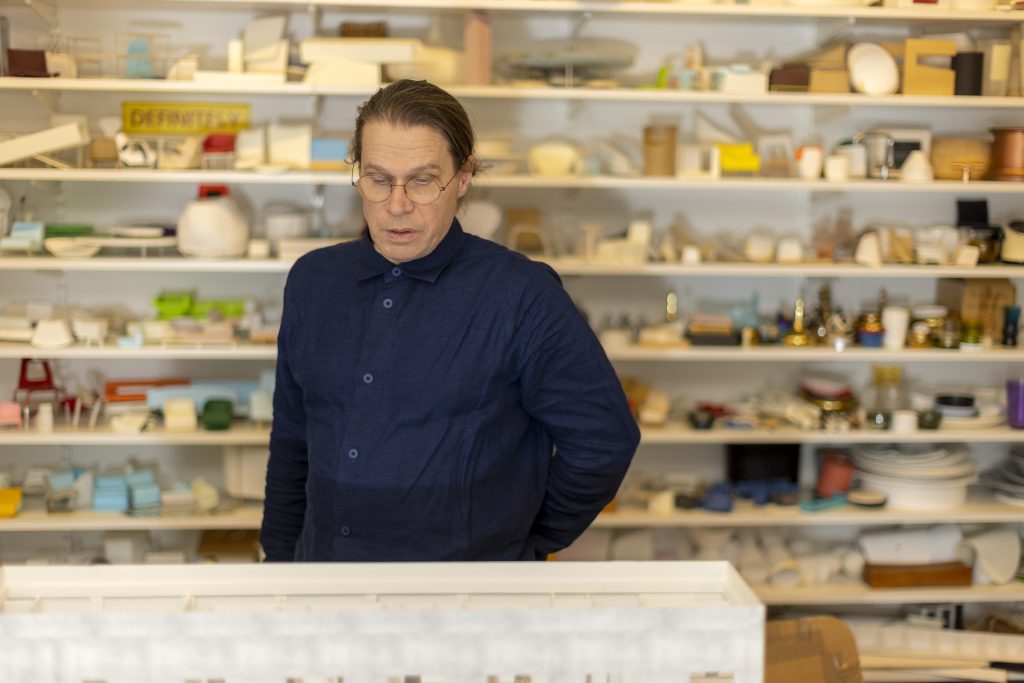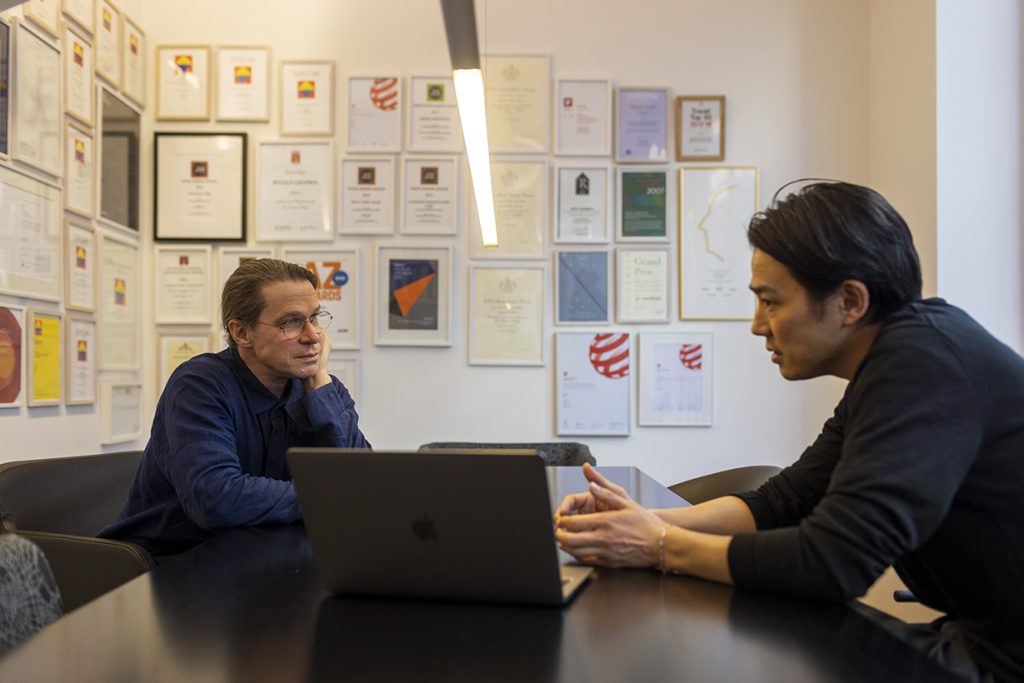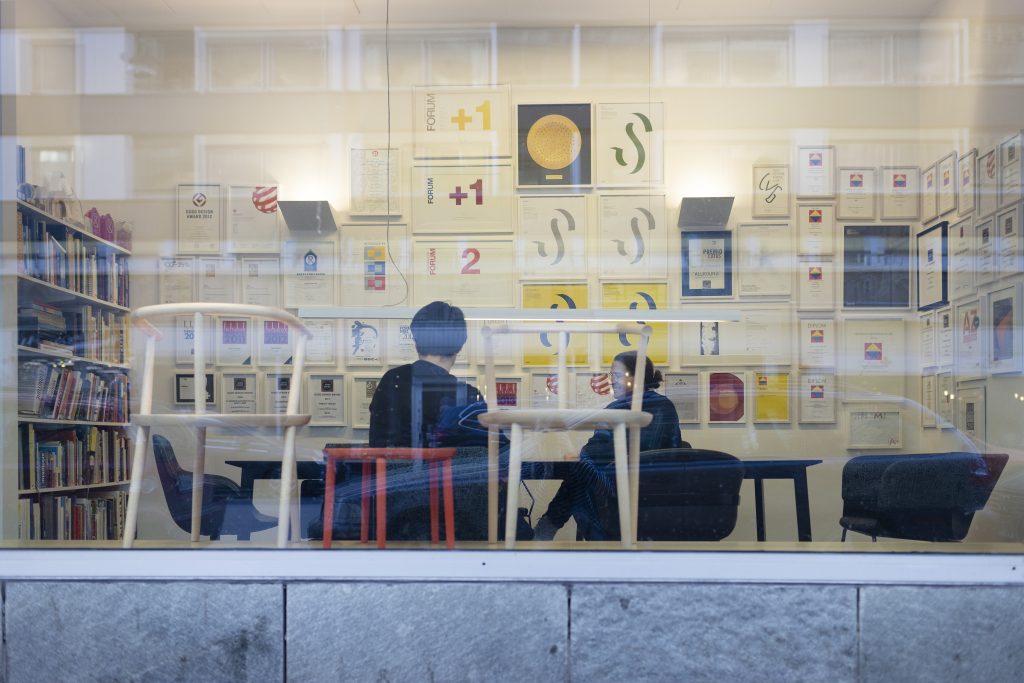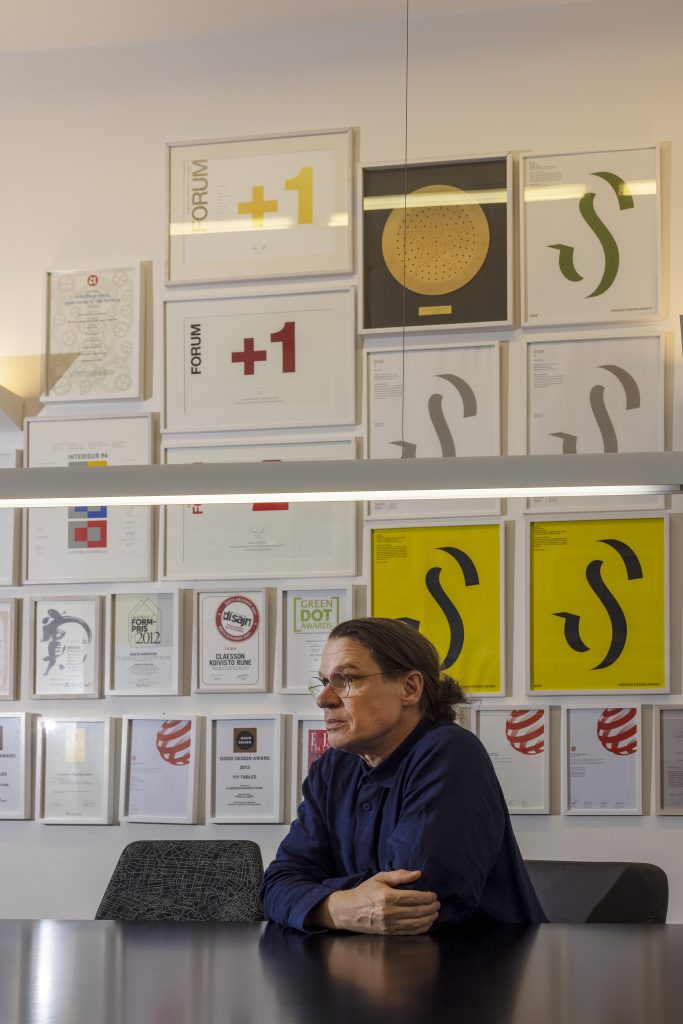


Music played by an orchestra named K5
A conductor that guides unique pieces
● First of all, please tell us about Claesson Koivisto Rune.
Eero and Marten met at Konstfack University in Sweden and quickly became good friends. During our four years of study together, our relationship was established, and after graduation, we started our own design studio. None of us have worked for any other company, so we have worked in our own unique way, and we couldn’t have asked for a better environment.
●How long have the three of you been together?
We met in 1990, so we’ve been together for 32 years now. I started my career in interior design and then moved on to project-related design and architecture. Our first major project was a house we built in the center of Stockholm called ‘Villa Vabi’. The three of us were inspired during our student days when we visited Japan with a grant from the Scandinavia Nippon Sasakawa Foundation. This house was designed based on the Japanese philosophy we had learned. Since then, we have been approached by various projects in Japan and have visited Japan whenever we have the opportunity, and each time we visit, we receive a lot of inspiration.
●What kind of inspiration do you get from Japan? And why are you attracted to Japan among so many other countries?
This is my own opinion, not necessarily that of all the three of us, but I think what is important in life is a neutral understanding. In order to make ordinary life feel special every day, we need to create a comfortable environment in our homes and workplaces. It is also important to eat good food and to be exposed to music, art, and design. I feel that we can get these types of insights by living in Japan. Japanese culture is multi-layered and I am still learning about it, but every time I visit, I have new questions that I hadn’t thought of before. That’s something that doesn’t happen very often when I visit other countries, and it’s inspiring.
●You never stop learning!
Yes, I think so. There is much to learn. Many people, such as Japanese craftsmen, who have been working on the same thing all their lives, will be humble when praised, saying in return, “I am still in the process of learning.” I think that is a very beautiful attitude. Life is like that. You learn, you study, you learn, and then you die. It is never fulfilling. I like that way of thinking. Working in architecture and design, Japanese crafts, design, fashion, food, everything is inspiring and I really get a lot of inspiration. I haven’t been able to go there for two years now. I miss Japan.
It is a very honest way of being, and it is a way of being of a town that can survive. Kabutocho will continue to grow in the future.
●Do you always stay in Tokyo? What do you find attractive about the city?
I was in Osaka when I worked on the Sphera Building in Kyoto, but I usually use Tokyo as my starting point. Tokyo is a big city, but also very small. That’s what makes it exciting. There are always interesting things happening, and I feel safe. When you try to experience something new in New York, there is often fear involved. That’s exciting, in its own way too. But in Tokyo, you get the same experience without the fear. I am also happy to be lured by the feeling of Tokyo. I’ve never wanted to live there, but I love the place that gives me everything. And I love any season. Even the very hot and humid summer. I’ve been riding my bike for a long time, so I know how to get to different places.
●Is a bicycle the best way to enjoy Tokyo?
Of course. Cabs are good for a couple of people talking, but they take time. It is also a long way to go from the east side of Tokyo to the west side. But if you go by bicycle, you will find that it is actually not that far. Next time I visit Japan, I would like to rent a bicycle and just ride. I want to smell the city of Tokyo.
●How did you feel about the “smell of Kabutocho”?
Smells are very hard to describe. What I see is a hectic and strange environment of buildings, roads, and highways. But at the same time, it is calm and quiet. Even though it is very close to Ginza, you don’t even realize the city exists until you walk around. Although I have visited many times, I had no idea there was such an interesting place located between Ginza and East Tokyo. It’s cool that despite being in the heart of Tokyo, it still feels a little unknown.
●Even if people were born and raised in Tokyo, there are many people who do not know about Kabutocho.
It has a stock exchange and, of course, has always been an important city from a business perspective. Every country has cities like this. Wall Street in New York or Frankfurt in Germany is full of people walking around in suits, ties, and white shirts. It is a common belief that such business districts are not very interesting, but what is happening in Tokyo right now is that a different spice has been added to such districts to make them more interesting. Many people who are interested in the city will come and make it interesting again. If we had built K5 in a town that had already developed a culture, it would have been just a hotel. I think it is unique because it was built here in Kabutocho.
●Brooklyn Brewery in New York decided to open a store in Tokyo, in large part because it was in Kabutocho. We were told that if it had been a new building, the store probably would not have happened.
So Brooklyn Brewery has decided to be adventurous! That’s cool.
● In the past two years, many stores have opened in Kabutocho. Have you heard about the new building called KABUTO ONE?
When we were staying in Kabutocho, it was still under construction. Regardless of the pandemic, I have heard that Kabutocho is growing well. It is not exploding, but it is growing slowly and gradually. It is a very honest way of being, and it is a way of being of a town that can survive. Kabutocho will continue to grow in the future.
As soon as guests enter, they feel as if they have earned a place of their own, as if they are part of the hotel. It's great that everyone can immediately become part of the community.
●How did you feel when you first heard about the K5 project?
When I learned who was creating this project, where, and on what basis, I knew this was going to be interesting. And the participation of three young people (Mr. Yuta Oka, Mr. Takahiro Homma, and Mr. Akihiro Matsui), who could have been our children’s age, made the project even more exciting. We had many meetings, and I think it was a very natural development. Some things that should have been there in the beginning were not, some new things came in and made sense, and as a result, everything made sense. Of course, there were difficult moments, but it was because of these hardships that we were able to create something better. It was the best teamwork I have ever experienced.
●All members spoke English, and many of them were very diplomatic, so it was a unique team with an international flavor.
And I think the three founders (Mr. Yuta Oka, Mr. Takahiro Homma, and Mr. Akihiro Matsui) were a complete group because of their different personalities. I am very glad that we had the courage to make the decision to make the guest rooms bigger. Even though it is a small hotel, we put tenants in the whole ground floor and basement. It is as if it were a huge hotel, with a restaurant, bar, and coffee shop all in this small hotel of 20 rooms. As soon as guests enter, they feel as if they have earned a place of their own, as if they are part of the hotel. It’s great that everyone can immediately become part of the community. I think this is how a hotel should be.
●We have to be open to the community and society.
Yes, I agree. I think it was a brave decision to bring out caveman because a restaurant cannot be built on hotel guests alone, especially since Kabi is doing so well. I think everyone involved in this project, whether they are still here or already in a different place, learned something. And it must have been a wonderful journey. For us, K5 was by far the most interesting hotel experience we have ever created. Now, it is as if everyone is taking care of K5, which is our child. We must develop and nurture it together with Kabutocho.
●What were your initial thoughts on the design of K5?
We had to watch the movement of people and come up with an effective scheme. We started thinking about how we can make people feel comfortable in this small hotel in Kabutocho? How to layout the tenants? And how do we attract people to the basement? We had to find a way to control, rather than completely separate, the paths leading people to the restaurant and to the guest rooms. Rather than forbid this path, we sought a way to make it easy to understand and fluid. Early on, we decided to build a corridor on the north side of the building facing the highway and to build the guest rooms in a quieter area, which I think was a great idea. Creating large windows and compartments in every room clarified our policy, and we decided to leave the walls, floors, and ceilings as they were, which I think was key to the design. It was also important that we did not make each tenant independent, but rather connected them loosely by using plants and shelves as partitions between spaces. Looking back now, it is clear what the right answer was, but at the time, everyone was coming up with ideas for a better way to do things, and we wanted to create the best possible product, so we proceeded with twists and turns.
The K5 project was like an orchestra, with specialists in different fields. And I think the word "conductor" fits us perfectly.
●Rather than design, we put a lot of effort into thinking about the structure. And when we actually put it into operation, we realized its power in a way that we could not see.
It is strange, isn’t it? While “weird” can have a negative connotation, I consider it a positively “weird” hotel. It is rare to find a hotel that functions in this way. The reception area, which was designed to look like a small wooden box, is something you will always pass by when you go to the restaurant or to the 2nd floor or Ao. I think it was a cool decision to make the reception the center of K5. It’s also important that when you check-in and make your way to your room, you are carefully guided to the elevators, stairs, and hallways. Even the highway running next to the hallway should lead to an uplifting feeling that something is going to happen here.
●If you don’t use the words design, architecture, or interior design in the two years you have been building K5, how would you describe your roles?
The K5 project was like an orchestra, with specialists in different fields. And I think the word “conductor” fits us perfectly. We didn’t know at first what kind of music it would be, but I am convinced that it turned out to be very unique. We all had our own ideas, and that was a big part of it. Everyone had a sense of responsibility that this project belonged to them, and they came up with ideas in their own words and senses. Suddenly, Hiro (Takahiro Homma) suggested putting a record player in the guest room, didn’t he? Along with art, we had many discussions about tackling plants in the guest rooms, and it was also significant that we were able to ask Mr. Kei Amano of Yard Works to help us. Everything we have discussed has been worthwhile, and everyone who participated is a part of K5.
K5 was created because specialists in various fields brought their ideas together in the same way. Heiwa Real Estate was also very important to the project. As the owner, you didn’t just rent the place out, you got involved with your own ideas. And they always had our backs.
●I also interviewed Mr. Kiyoyuki Tsuchimoto, President of Heiwa Real Estate, and he told me that it is important to challenge yourself and get out of your comfort zone.
Getting out of your comfort zone is a good word. All of us were outside our comfort zones, but together we felt safe to proceed. We made a lot of different decisions, but I think all of them together made music like an orchestra.
●What genre of music do you think the K5 orchestra plays? Classical, jazz, or hip-hop?
I think the sound of the music called K5 will be different for those who enjoy music and those who do not. Because there are so many tones, I think it sounds different from time to time. Some days it may sound like funky jazz. It may not be royal classical, but it could be experimental classical. It would be too bold to call it Mozart. Maybe it’s more contemporary music; I encourage all visitors to K5 to listen. What kind of music comes to mind when you are here?
Different elements come together to make the space, even if you sometimes wonder where they are ultimately headed.
●If you had to choose just one product designed by K5, which one would you choose?
It’s hard to pick one, and like the music story, it depends on my mood. But I do like the smallest stool in B. The small two-seater sofa is also nice. The curtains have so much more functionality than you would imagine from their appearance. It’s hard to pick just one of them, so I won’t, but I think the various elements come together to create everything. But I guess the most important point is, as I said before, that we left the walls, ceiling, and floor as they are.
●Aristotle of ancient Greece said that combinations are important, and when I asked Mr. Teruo Kurosaki, the founder of IDÉE, what he thought of K5’s interior, he told me that I should trust my instincts even if I could not see the whole picture.
I think he is right. Different elements come together to make the space, even if you sometimes wonder where they are ultimately headed. We had never worked on so many details for a single space with this quality before. Whether it’s the beautiful lanterns or the wall lights in the hallway that I sketched, all the interiors are in harmony. It was interesting to be able to show the interiors in such a different context, each with a high level of design, each building the music in a certain way.
●Do you want to build K5 in Stockholm?
It would be a unique project. But it will never be the same as Kabutocho again. It will be a completely different approach and context.
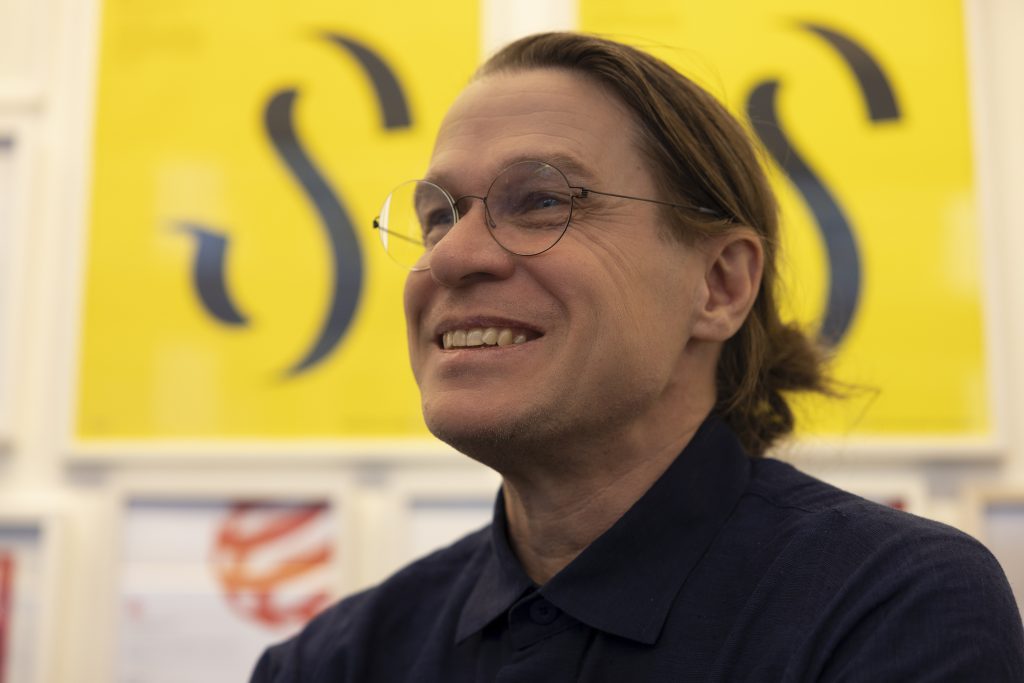
Ola Rune
After graduating from Konstfack University, he founded the design studio Claesson Koivisto Rune with Morten Claesson and Eero Koivisto in Stockholm in 1995. They are internationally active in multiple fields of architecture and design, from buildings for Gucci, Sony, and Louis Vuitton in Stockholm to everyday items such as the Neo kitchen tool from Iittala. In Japan, C.K.R. is familiarly known as C.K.R. In 2017, Rune held his first art project exhibition in Tokyo.
Text : Momoko Suzuki
Photo : Gustav Karlsson Frost
Interview : Akihiro Matsui
